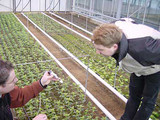Ideal Climate for vegetables
If plants are to thrive in a greenhouse under optimal conditions, the indoor temperature should be monitored and regulated at various points. Radio-linked sensor networks are a flexible and inexpensive solution, particularly as they eliminate the need for wiring.
To grow flowers and vegetables in greenhouses, market gardens in middle europe on average use over 90 percent of their entire annual energy consumption just for heating. Establishing the ideal climatic conditions for each type of plant is a question of cost, because the greenery flourishes faster and thus makes room sooner for the next generation of plants. The outside weather affects the indoor climate. This is why it is monitored by sensors whose data regulate the air conditioning technology. Since these parameters vary at different times and in different places, they need to be measured at a sufficiently high resolution. A network of wireless radio sensors makes it possible to monitor the indoor environment without using an elaborate system of wires which, in large greenhouses, can also be very long. The network was set up by researchers from the Fraunhofer Institute for Microelectronic Circuits and Systems IMS. Their testing ground consists of a few greenhouses belonging to the North Rhine-Westphalian Chamber of Agriculture at the Straelen horticultural center, about 40 kilometers west of Duisburg.
Another advantage of this µNode network is that the sensor nodes form a distributed computer system using microcontrollers as miniature brains. The sensor data is pre-processed in this system, ensuring that only the values that are relevant for describing the indoor environment ever reach the base computer. The low bandwidth that this occupies simplifies the entire network architecture. The tiny sensor boxes moreover use so little power that they can operate for several months with conventional batteries. “Even the temperatures measured at various heights above the plant containers and on the heaters have resulted in an improved climate,” insists Otto Domke, utility services adviser to the horticultural center. “We therefore plan to extend the new measuring and control elements to the air and soil humidity, the lighting intensity and possibly even the pH value of the soil.”
Experience gained from using wireless sensor networks in agriculture could be applied to entirely different fields as well, as Hans-Christian Müller, IMS group manager for hardware-software architectures, sums up: “Whenever and wherever physical, chemical or other parameters need to be recorded at a high spatial resolution, such sensor networks are an attractive solution. They are cost-effective and can be used even in places where wiring is not a viable option.” The researchers will be presenting their know-how at the Hanover trade fair from April 11 to 15 – in the “Wireless Pavilion” A46 in Hall 7.
